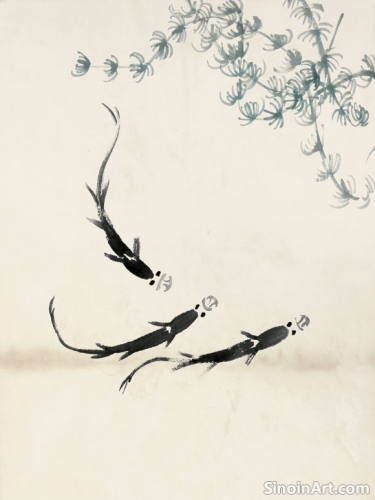The "Three Perfections" in Xieyi
|
The concept of the "Three Perfections" (sānjué 三絕) – poetry, calligraphy, and painting – is central to understanding the literati ideal and its influence on Xieyi. This concept emphasizes the integration of these three art forms as a holistic expression of the artist's personal feeling, thought, and understanding of the world. It is a complete and comprehensive artistic expression.  A literati artist would strive to master all three disciplines, viewing them as mutually enriching and equally important. The ability to write beautiful poetry, create expressive calligraphy, and paint with skill was considered the hallmark of a cultured individual. All three disciplines were important for a complete expression.  In Xieyi painting, the influence of calligraphy is particularly evident in the use of calligraphic brushstrokes. The artist aims to create lines that are not only visually appealing but also imbued with energy and expressiveness. The painter’s brushwork is directly related to the skill of a calligrapher.  The incorporation of poetry into Xieyi painting enhances the meaning and impact of the visual elements. The artist often selects poems that resonate with the subject matter and their personal vision, adding a new dimension to the artwork. It elevates the expression to a higher level of integrated creativity. The "Three Perfections" represent a holistic approach to art, emphasizing the importance of personal expression, intellectual cultivation, and a deep connection to the cultural and philosophical traditions of China. The artist sought an integrated and complete expression that combined all three disciplines. It is the complete union of artistic expression. |
Tag : Three Perfections, Sanjue, poetry calligraphy painting, literati ideal, Chinese art forms
Related information
- Xieyi Painting and the Expression of Emotion
- Xieyi and the Influence of Poetry
- Xieyi Painting and the Concept of "Intention Before the Brush"
- Exploring the Subject of Flowers in Xieyi
- The Importance of Practice in Xieyi
Xieyi painting is a powerful medium for expressing a wide range of emotions through brushstrokes, ink washes, subject matter, and the artist's state of mind, connecting with viewers on a deeply human and emotional level.
Xieyi painting is profoundly influenced by poetry, with literati artists integrating verse into their paintings, applying similar principles of rhythm and expression, and using symbolic imagery to convey complex ideas and personal feelings, emphasizing the interconnectedness of these art forms.
"Intention Before the Brush" (yi zai bi xian) is crucial in Xieyi painting, emphasizing that the artist's vision, emotional state, and purpose should guide their brushstrokes, requiring thoughtful preparation and planning while valuing spontaneity, imbuing the artwork with inner spirit and emotional truth.
Flowers are a popular subject in Xieyi painting, imbued with symbolism and conveying a range of emotions. Artists focus on capturing the essential nature and vital energy of flowers through suggestive brushstrokes and subtle color washes, creating a meditative appreciation of nature's beauty.
Dedicated and consistent practice is essential for mastering Xieyi painting, developing technical skills, intuition, and spontaneity, while also fostering patience, perseverance, and a deeper understanding of the art form's philosophy and aesthetics, transforming the practice into a form of self-discovery.